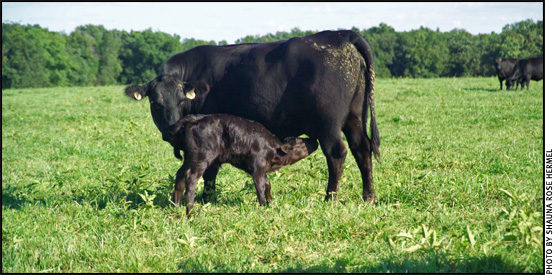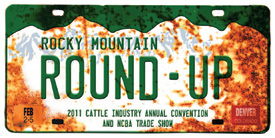HEALTH & NUTRITION...

Assisting at Birth
K-State's Matt Miesner offers tips for determining when assistance is needed.
If a cow or heifer is taking too long in labor, and the feet of the calf are not yet showing, it's always wise to check the position and size of the calf to see if assistance is needed.
Matt Miesner, assistant professor of clinical ag practices at Kansas State University's (K-State's) Veterinary Teaching Hospital, says you need to determine which legs of the calf you are feeling — whether front or back. You can usually tell by feeling the joints to know whether you are feeling the knees or hocks. The first two joints in the front leg flex the same direction. In the hind leg, the hock bends the opposite direction of the fetlock joint. Read more.
Breath of Life
There are some tricks you can use to get a calf to breathe on its own.
Sometimes after a difficult birth the calf is sluggish and doesn't start breathing on its own, especially if it has been deprived of oxygen for too long during birth. According to Matt Miesner, Kansas State University, there are some drugs and some techniques that can help stimulate the calf to breathe. Read more.
 Antimicrobial Use
Antimicrobial Use
Expect more attempts to limit or eliminate use of antibiotics in the beef industry.
The livestock industry's use of antimicrobial products — and antibiotics in particular — continues to draw criticism by activist groups, the media and politicians. They worry that it is leading to increased resistance among disease-causing organisms and reduced efficacy of antimicrobial therapy in humans. According to Mike Apley, veterinarian and Kansas State University (K-State) professor, the call for change is coming from mainstream advocacy groups as well as the radical fringe.
Speaking during a Cattlemen's College® session of the 2011 Cattle Industry Convention in Denver, Apley said extremist groups use fear tactics to promote their agendas. They cite hyper-inflated numbers regarding the extent to which subtherapeutic antimicrobial treatment is applied to livestock production. Read more.
 Preventing Lameness
Preventing Lameness
Experts share how and why cattle become lame.

Rick Rasby
Ridin’ Herd
Water is an important nutrient.
Many times we often overlook the importance of water for beef cattle. We get caught up in balancing beef cattle diets for energy, protein, vitamins and minerals for a given targeted level of performance. Of the nutrients listed, water is most critical. The minimum requirement of cattle for water is a reflection of that needed for body growth; for fetal growth or lactation; and of that lost by excretion in the urine, feces or sweat, or by evaporation from the lungs or skin. Anything influencing these needs or losses will influence the water needs of livestock. Read more.
Detecting Disease
New report indicates U.S. needs faster, more efficient tools to screen livestock, milk and other agricultural products for highly contagious diseases.
The National Center for Foreign Animal and Zoonotic Disease Defense (FAZD Center) in mid-February released a new report that identifies the screening tools the United States will need to more quickly and efficiently detect highly contagious diseases in its livestock, milk and other agricultural products.
The report resulted from the Agricultural Screening Tools Workshop conducted in November 2010 in Washington, D.C. The FAZD Center and the Department of Homeland Security (DHS) sponsored the workshop, which attracted 40 representatives from DHS, the U.S. Department of Agriculture (USDA), the Federal Bureau of Investigation (FBI), major research universities, animal disease diagnostic laboratories, and agricultural industry associations. Among these representatives were some of the nation's leading diagnostic experts in foreign animal and emerging diseases. Read more.
An Anaplasmosis Vaccine
Louisiana company produces a unique cattle vaccine to prevent anaplasmosis.
A product manufactured and marketed by a Louisiana company is the only killed vaccine available to prevent anaplasmosis, a disease that costs U.S. cattle and dairy producers an estimated $300 million a year.
Anaplasmosis, a disease caused by an intracellular microorganism, destroys red blood cells. Clinical signs include severe and profound anemia, and the mortality rate escalates as animals become older and have a higher need for oxygen, Luther says. The greatest problems are with pregnant and nursing cows. Read more.
Cattle Diseases: Common Conditions/Terms
Click here for a list of common conditions and terms related to beef cattle diseases, such as anaplasmosis, brucellosis, BVD, E. coli, IBR and others.
[Click here to go to the top of the page.]





